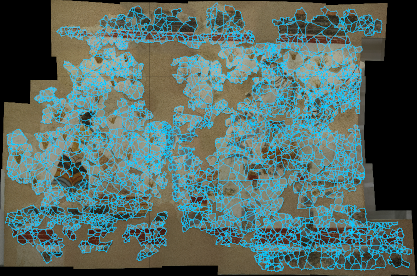Analyzing Fracture Patterns in Theran Wall Paintings
International Symposium on Virtual Reality, Archaeology, and Cultural Heritage (VAST), September 2010

Abstract
In this paper, we analyze the fracture patterns observed in wall paintings excavated from Akrotiri, a Bronze-age
Aegean city destroyed by earthquakes preceding a volcanic eruption on Thera (modern Santorini) around 1630
BC. We use interactive programs to trace detailed fragment boundaries in images of manually reconstructed wall
paintings. Then, we use geometric analysis algorithms to study the shapes and contacts of those fragment boundaries, producing statistical distributions of lengths, angles, areas, and adjacencies found in assembled paintings.
The result is a statistical model that suggests a hierarchical fracture pattern, where fragments break into two
pieces recursively along cracks nearly orthogonal to previous ones. This model could be useful for predicting
fracture patterns of other wall paintings and/or for guiding future computer-assisted reconstruction algorithms.
Links
Citation
Hijung Shin, Christos Doumas, Thomas Funkhouser, Szymon Rusinkiewicz, Kenneth Steiglitz, Andreas Vlachopoulos, and Tim Weyrich.
"Analyzing Fracture Patterns in Theran Wall Paintings."
International Symposium on Virtual Reality, Archaeology, and Cultural Heritage (VAST), September 2010.
BibTeX
@inproceedings{Shin:2010:AFP,
author = "Hijung Shin and Christos Doumas and Thomas Funkhouser and Szymon
Rusinkiewicz and Kenneth Steiglitz and Andreas Vlachopoulos and
Tim Weyrich",
title = "Analyzing Fracture Patterns in {Theran} Wall Paintings",
booktitle = "International Symposium on Virtual Reality, Archaeology, and Cultural
Heritage (VAST)",
year = "2010",
month = sep
}